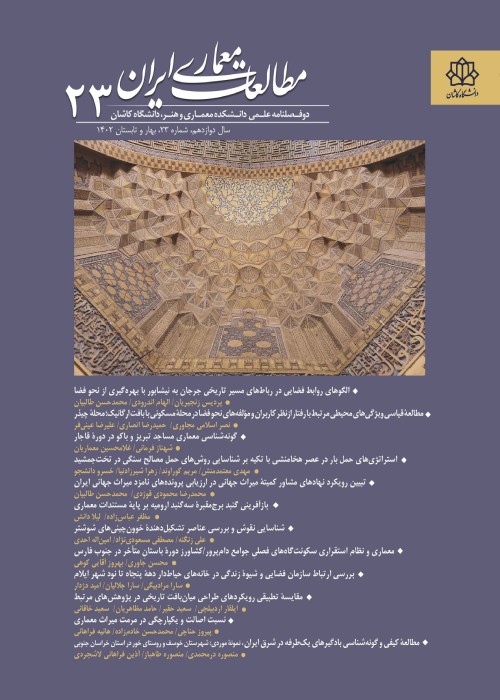The Decorations and Their Ornamental Value in Residential Architecture During Muzaffarid Dynasty in Yazd, Iran
Abstract:
The Muzaffarid is one of the most important historical periods, which brought glory and prosperity for Yazd as well as providing peace and stability in the region for half a century. Construction of various structures and residential buildings flourished during this period, which their structural decorations and architectural ornamentations styles and techniques were diverse and demanding. However, not much research has been conducted in this respect and thus the present study aims investigate and elucidate the place of architectural decoration styles of this period through a historical and descriptive approach. The research was conducted via two steps; first, the historical data were collected from related historical documents and manuscripts; and second, the data and their documentation were provided via field studies based on the previously collected data for the final analysis. The present study seeks to address the following research questions that what are the commonly applied decorative styles in the houses of Muzaffarid period. Then what are the properties and dimensions of these decorative styles in the houses found in both urban and rural fabric in the region. Finally, what is the place and state of these decorative styles in residential architectural of Muzaffarid period. Based on the results several styles of decorations such as mud decorations, TONGBORI, stucco works as well as decorative corbel vaults, murals etc. are applied in the surveyed residences. Construction of some of these decorative styles was quite simple and primary by ordinary construction tools that are still visible in some houses. However, there are other complex decorations, which have demanded a certain delicacy and elegance in the few instances manifesting the social status of the owner or the importance of that village or the town. The mud work decorations with their unique implementation techniques were the most commonly used decorative element in the houses of this region during this period, which can be used as an indicator for evaluating the significance of the structure.
Keywords:
Language:
Persian
Published:
Journal of Iranian Architecture Studies, Volume:5 Issue: 9, 2016
Pages:
101 to 122
magiran.com/p1585773
دانلود و مطالعه متن این مقاله با یکی از روشهای زیر امکان پذیر است:
اشتراک شخصی
با عضویت و پرداخت آنلاین حق اشتراک یکساله به مبلغ 1,390,000ريال میتوانید 70 عنوان مطلب دانلود کنید!
اشتراک سازمانی
به کتابخانه دانشگاه یا محل کار خود پیشنهاد کنید تا اشتراک سازمانی این پایگاه را برای دسترسی نامحدود همه کاربران به متن مطالب تهیه نمایند!
توجه!
- حق عضویت دریافتی صرف حمایت از نشریات عضو و نگهداری، تکمیل و توسعه مگیران میشود.
- پرداخت حق اشتراک و دانلود مقالات اجازه بازنشر آن در سایر رسانههای چاپی و دیجیتال را به کاربر نمیدهد.
In order to view content subscription is required
Personal subscription
Subscribe magiran.com for 70 € euros via PayPal and download 70 articles during a year.
Organization subscription
Please contact us to subscribe your university or library for unlimited access!



